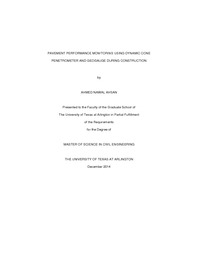
ATTENTION: The works hosted here are being migrated to a new repository that will consolidate resources, improve discoverability, and better show UTA's research impact on the global community. We will update authors as the migration progresses. Please see MavMatrix for more information.
Show simple item record
| dc.contributor.author | Ahsan, Ahmed Nawal | en_US |
| dc.date.accessioned | 2015-07-01T17:50:34Z | |
| dc.date.available | 2015-07-01T17:50:34Z | |
| dc.date.issued | 2014-12 | |
| dc.date.submitted | January 2014 | en_US |
| dc.identifier.other | DISS-12954 | en_US |
| dc.identifier.uri | http://hdl.handle.net/10106/24963 | |
| dc.description.abstract | Proper design life of road network system requires adequate quality control measures during the construction process to ensure proper material quality and sufficient strength in between the materials. Laboratory tests are often time consuming and sometimes, are not practical while the construction work is going on, in-situ techniques can efficiently evaluate the material properties through simple and less time consuming procedures. Dynamic Cone Penetrometer and Geogauge can play a vital role as an in-situ testing equipment because both have the potential to measure the change in material properties through field tests being performed in the field. Both in-situ techniques was not extensively used in North Texas area. Frequent use of these two equipment during the construction process can expedite the whole construction process because both are hand-held devices and can be conducted within a short amount of time, often in minutes. For this study, Dynamic Cone Penetrometer and Geogauge was used to assess the material properties from the tests performed on five construction sites of Horseshoe Project around Dallas, TX. Several points across the width of the pavement have been considered to perform these in-situ tests along with Nuclear Density Gauge test in two of these sites. A thorough analysis has been conducted for the material properties to be determined. Dynamic Cone Penetrometer and Geogauge both were consistent to measure the change in in-place material characteristics of the pavement materials. The design thickness of cement treated base layer where the tests were being performed was 6". DCP was efficient enough to detect the layer thickness up to a proximity of 0.5 inch and was also able to distinguish layer anomalies between the pavement layers. Cement stabilized base layer provided with a DCPI value which ranges from 0.5 mm/blow to 8 mm/blow whereas, DCPI values were observed to remain within a range of 2 mm/blow to 22 mm/ blow. For the top 6" cement treated base layer, unconfined compressive strength was found vary between 210 psi to 1023.5 psi. The highest resilient moduli value was found at the middle of the cement stabilized base layer where it varied from 40,500 psi - 623,285 psi. Young's moduli values for cement stabilized base layer measured with Geogauge also followed the same trend of resilient moduli obtained from the measurements taken with Dynamic Cone Penetrometer. | en_US |
| dc.description.sponsorship | Hossain, Sahadat | en_US |
| dc.language.iso | en | en_US |
| dc.publisher | Civil & Environmental Engineering | en_US |
| dc.title | Pavement Performance Monitoring Using Dynamic Cone Penetrometer And Geogauge During Construction | en_US |
| dc.type | M.S. | en_US |
| dc.contributor.committeeChair | Hossain, Sahadat | en_US |
| dc.degree.department | Civil & Environmental Engineering | en_US |
| dc.degree.discipline | Civil & Environmental Engineering | en_US |
| dc.degree.grantor | University of Texas at Arlington | en_US |
| dc.degree.level | masters | en_US |
| dc.degree.name | M.S. | en_US |
Files in this item
- Name:
- Ahsan_uta_2502M_12954.pdf
- Size:
- 2.169Mb
- Format:
- PDF
This item appears in the following Collection(s)
Show simple item record


